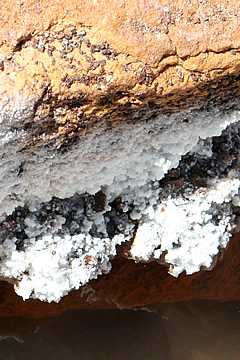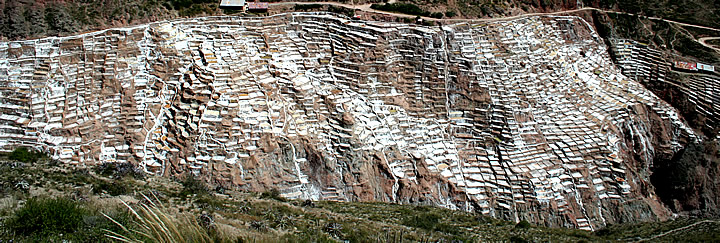

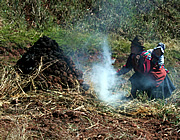
We saw some wonderful things in this area - the peaceful village of Chinchero with its Inca ruins and steep terraces, the drive across the High Sierra to reach the fascinating archaeological site of Moray, and finally the amazing dazzling expanse of the Maras salt pans.
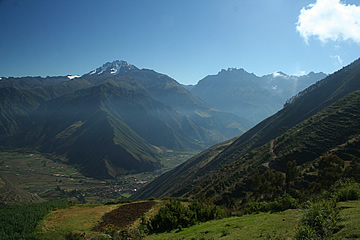
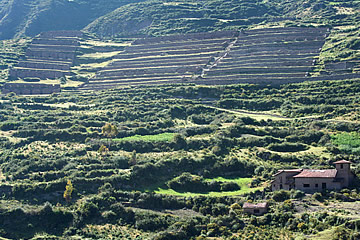
Early one morning we drove up to this Andean Indian village in the High Sierra - at 3762m one of the highest places we visited in Peru. As we climbed 300 metres from the Urubamba valley floor the scenery became increasingly spectacular.
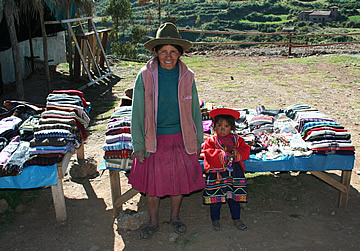
At one point where we stopped we could see impressive terraces and storehouses - the mountainsides were exploited by the Incas as much as possible for their agricultural needs.

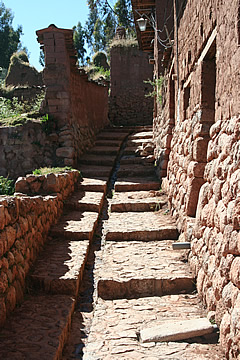
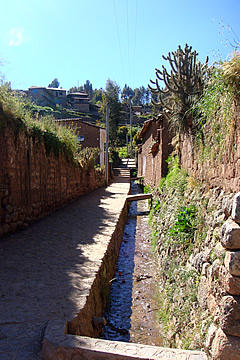
Chincherro is built on a steepish hill - the older buildings cluster around the top while the village spreads down the slope and along the incoming road. It sits on the high sierra with the magnificent Andes in view.
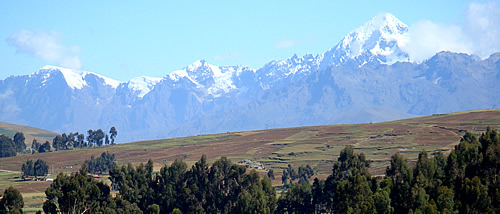
Chinchero is essentially a Spanish colonial village built on an Inca settlement. Many of the buildings incorporate Inca walls, the very distinctive angled Inca walls surmounted by vertical colonial walls. These aren't high class walls, not the precision cut stones of temples, but rather the rougher, but still impressive, walls of the countryside.
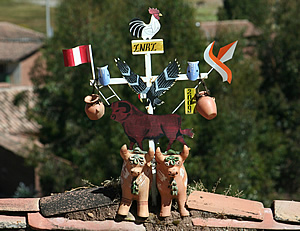
Many of the houses have small clay good luck bulls on the roof, with all kinds of additions such as bottles and jugs - whatever the owner regards as a good luck symbol - or perhaps symbols of an enterprise that they are hoping will be blessed with good luck.
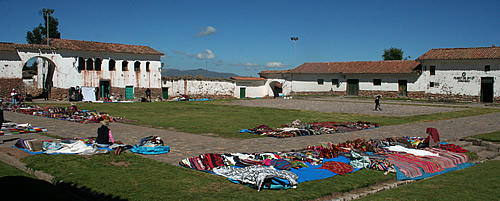
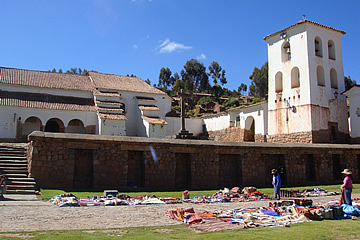
The little adobe church was built on the foundations of an Inca building, possibly a palace of Inca Tupac Yupanqui. It is beautifully decorated inside, with painted designs on the walls and an amazing painted ceiling (no photography allowed inside, it was rather dark in any case).
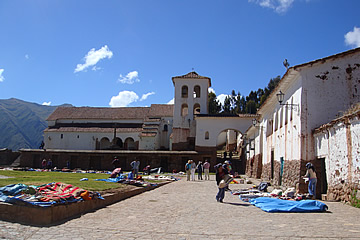
Outside the church walls are also painted, one painting was described to us as a battle of Inca vs Inca. The protagonists wear European dress and ride horses and use muskets, as well as sling shots, so I'm not sure if this is correct. It is likely to be a depiction of one or other of the late 18th century revolts against the Spanish who used Indian as well as Spanish troops.
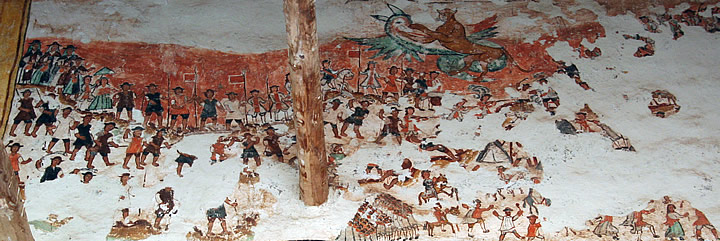
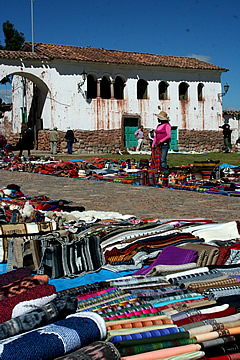
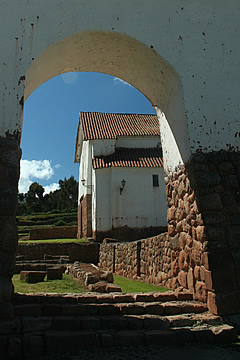
As this painting shows a puma triumphing over what looks like a dragon it could be the Battle of Sangarar which Tupac Amaru II and his Indian army won, though it was followed by a massacre of the Spanish so why it would be painted on a colonial church is a mystery.
To the south of the church is a spacious square surrounded by colonial buildings. On the east side of the square is the finest house in the village, though not in a great state. It has columned windows on the first floor and was the birthplace of Pumacahua, the cacique (local tribal chief) of Chinchero. He fought with the Spaniards against Tupac Amaru II.
Below the church on this square is an impressive Inca wall with nine very large trapezoidal niches - the continuation of the wall past the steps to the church has three similar niches. These niches seem to be a feature of this Inca site.

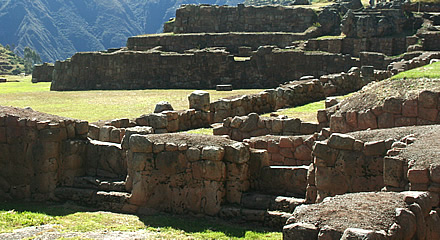
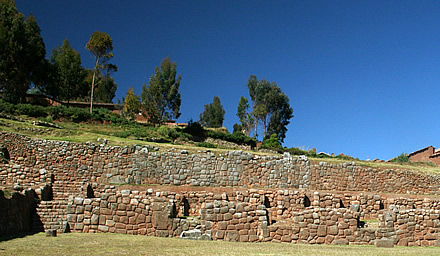
But the most interesting area is that to the west of the church which has substantial remains of Inca buildings and magnificent terraces.
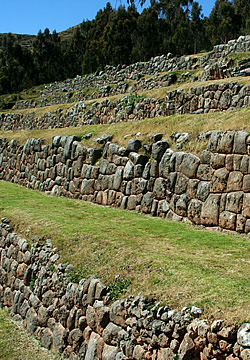
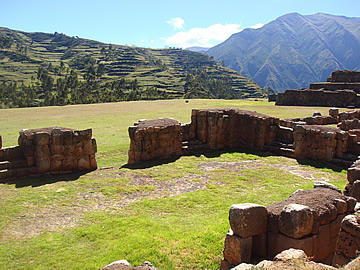
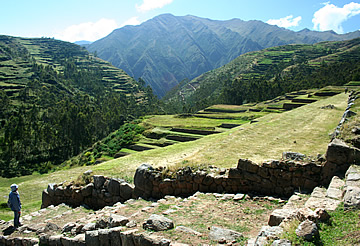
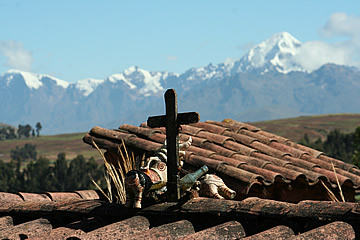
One of the buildings has triple-recessed apertures so it must have been an amazingly important place.
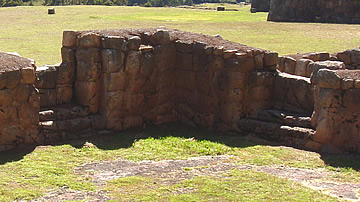
Past the remains of these rooms the terraces plunge down the mountainside.
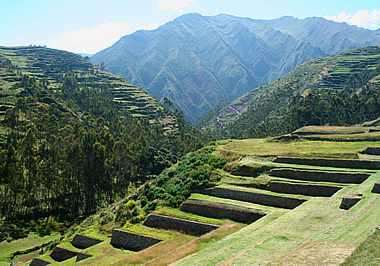
Chinchero is a lovely place, peaceful and with impressive archaeology. There were very few vistors here, only a film crew and a group of about half a dozen tourists. I really hope the nearby planned airport is scrapped - it would ruin both this lovely town, the peacefulness of the High Sierra, and Machu Picchu, bringing thousands more tourists every day. For the moment the skies are free of noisy polluting aircraft - may it always remain so.

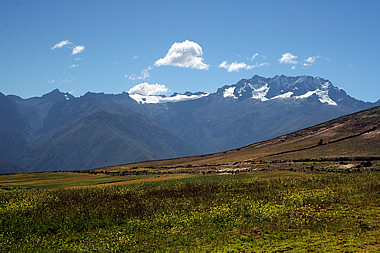
Leaving Chinchero our guide and driver asked if we'd mind going cross country rather than back to the main road. We had no objection whatsoever, it sounded much more interesting, and as we were in a four wheel drive vehicle the rough unpaved tracks were no problem.
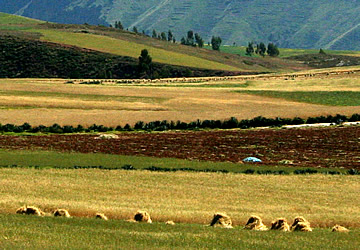
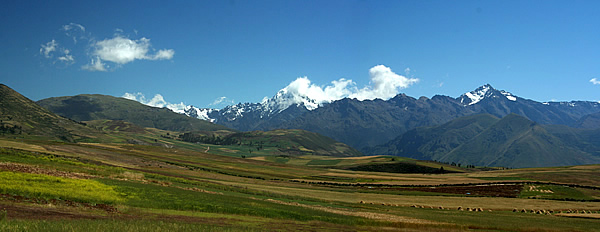
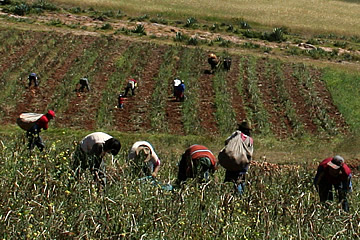
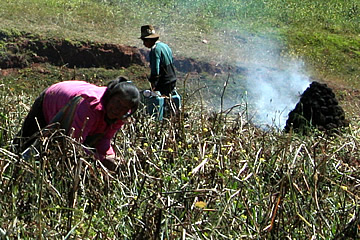
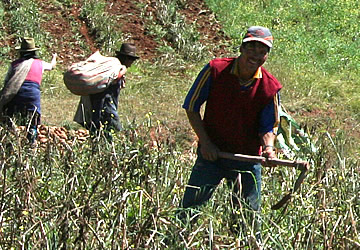
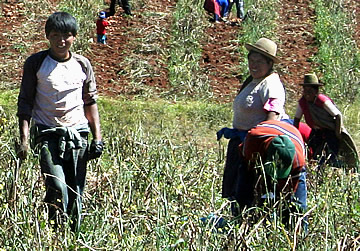
It was a wonderful drive over the high sierra with the snowy peaks across the unseen valley.
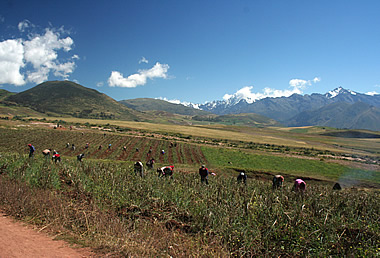
The potato harvest was in full swing. I got one of my best photographs of the trip, a mother with her child in a sling on her back, stoking the clay potato oven. Lunch would be the potatoes and chicha - the ubiquitous local drink usually made from maize, either fermented or unfermented. It has been made in the region for thousands of years - the Inca used it copiously in their ceremonies.
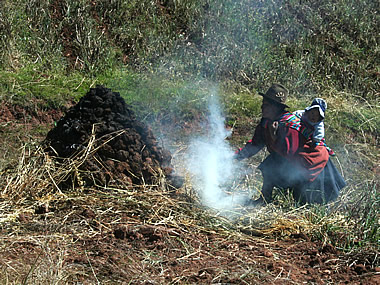
Everyone joins in the harvest: men, women and children - babies and toddlers accompanying the group, though there are probably more back home with the more elderly. These people were lovely - they didn't mind having their photographs taken and joked with our guide and driver.
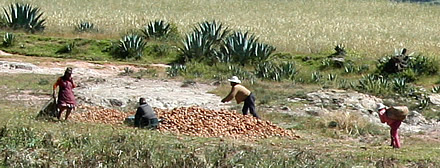
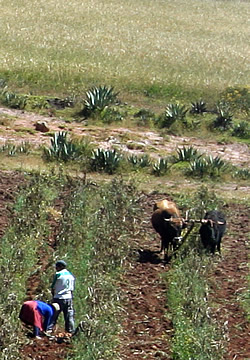

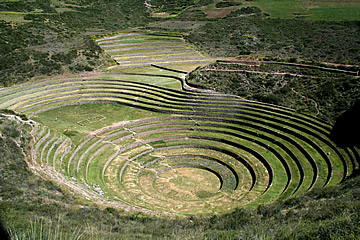
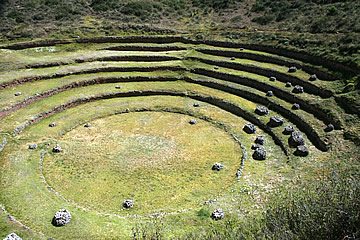
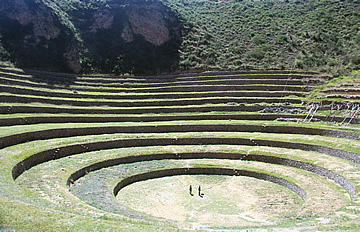
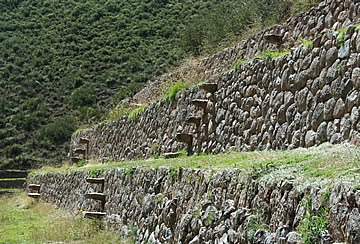
This curious Inca site is most often described as being some kind of agricultural laboratory. There are three sets of concentric terraces, each with an irrigation system, and there is no doubt that the different locations, levels and aspects would afford different climatic conditions. But it does seem a bit of a leap of faith to describe them as testing centres for genetic experimentation with crops. Whatever their purpose, it's a very atmospheric site in a beautiful location.
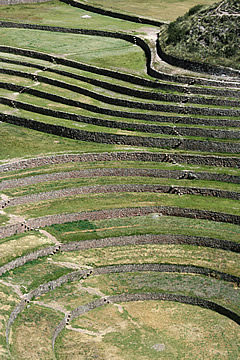
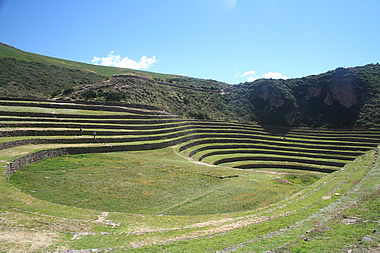
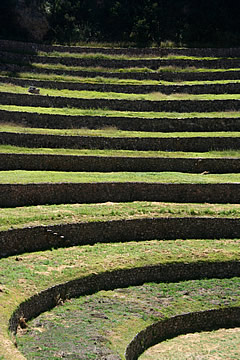
One set of terraces has been renovated, the other two are undergoing work. We walked down into the renovated set of terraces and the increase in temperature was very noticeable, and no cooling breeze.
We used the Inca steps - the stones set into the terrace walls. Wonderful to think we were walking in the footsteps of Incas! Or rather leaping - in some cases the steps are quite widely spaced! There is a large platform with the foundations of a building about half way down. Though it's postulated it could have been storehouses, no-one really knows.
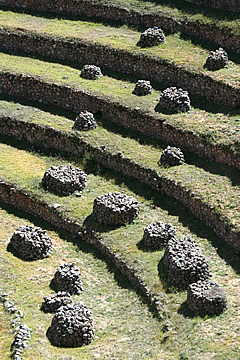
One of the sets of unrenovated terraces had large piles of stone in no particular order; I suppose they could just be loose stones gathered together ready for use.
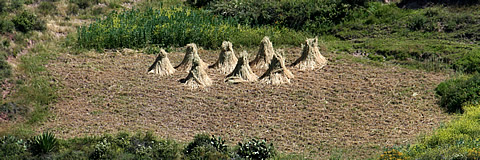
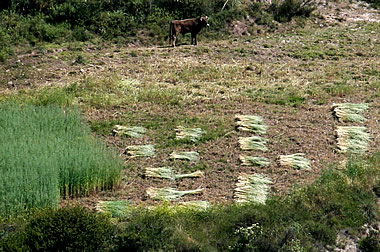
There is evidence of agriculture still being carried out here - bundles of cut reeds and drying conical stooks.

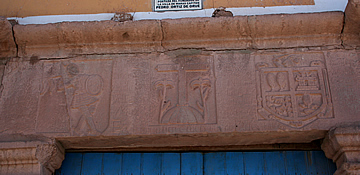
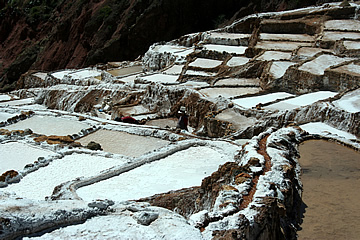
The town of Maras was founded by the Spaniard Pedro Otiz de Orué and is notable for its carved door lintels and quiet, picturesque streets. We passed through the town on our way to the salt pans. These are an amazing sight, dazzling in the sun.
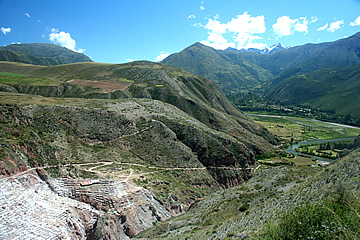
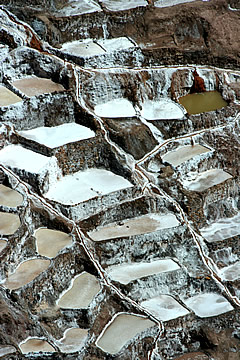
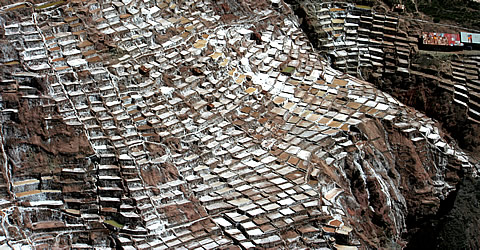
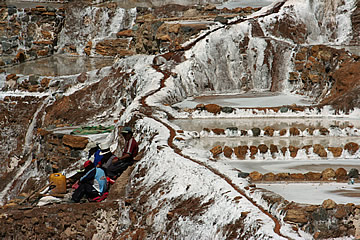
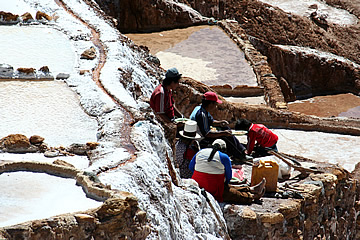
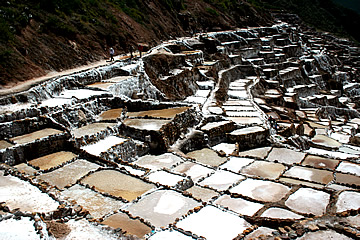
Salt has been extracted here since well before the time of the Incas. The salt pans consist of hundreds of shallow, terraced pools fed by a single warm, salty spring. The water descends via an intricate network of narrow channels to feed all of the pools. As the water evaporates the salt precipitates out in the form of crystals.
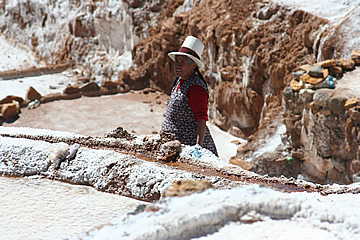
The local people work the ponds in a traditional system of blocking the water flow into their pond when salt crystals have formed sufficiently to be harvested. the pond dries rapidly in the hot sun and the salt is collected.
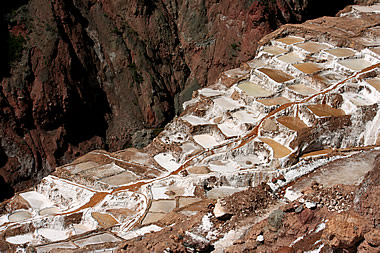
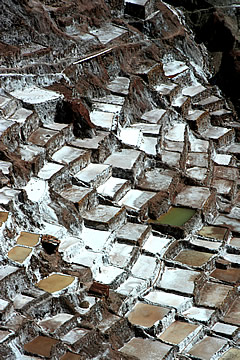
We walked along the edges of the pools, on narrow tracks, watching some of the local people at work, though it was soon lunch time and they settled down to eat. As in the potato harvesters in the high sierra, this looked like a family enterprise.
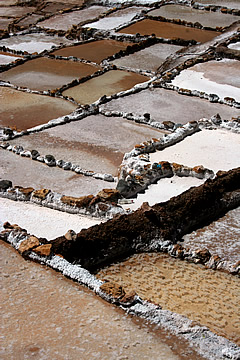
Maras was our final visit in the Sacred Valley region. The time spent in this area was wonderful, not just for the magnificent Inca ruins, but also to see the local people and their way of life today.
